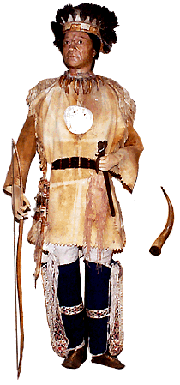
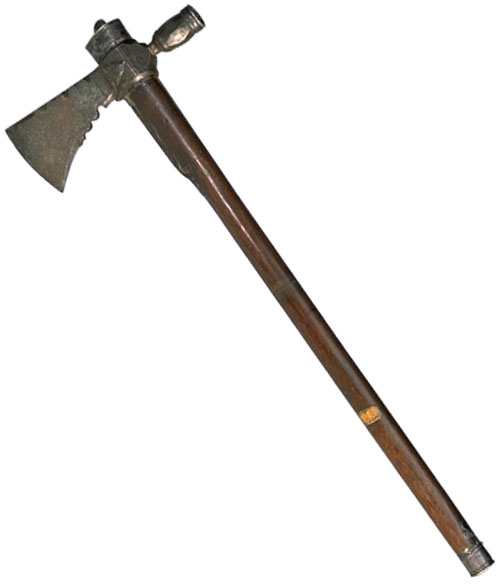
Some of the nicest and most ornate French axes given to the natives during and after the New-France era are the presentation axe types which are coined "casse-tête à calumet" or French pipe tomahawks. There is a mention in Watteville's "La Nature" of presentation pipe-tomahawks being given to indian chiefs by Louis XV : "Louis XV finished the seven year old war with the treaty of Paris. To recognize the services rendered by a hundred indian chiefs from various tribes which had fought for France against the English, the King had ordered from the manufacture of Versailles a hundred pipe-tomahawks carrying the royal "fleur de lys" , and the date "1763" on the bowl. (Oscar de Watterville, La Nature, 23 Octobre, 1897).
Louis XV termine la guerre de sept ans par le néfaste traité de Paris. Pour reconnaître les services rendus par cent chefs des tribus indiennes qui avaient combattu pour la France contre les anglais, le roi fit faire à la manufacture de Versailles cent pipes-tomahawks portant la fleur de lis royale sur le fer, et la date de 1763 sur le fourneau. (Oscar de Watteville, La Nature, 23 Octobre, 1897)
The mannequin from the "Musée de l'homme", exhibited in the "Cabinet du Marquis de Sérent" collection at Versailles, is equipped with a presentation pipe-tomahawk that is identical to other specimens collected in North America. We can say that this pipe-tomahawk is most likely one of the ones manufactured at Versailles in the early part of the 1760s.


Pipe-tomahawk in the hand of the mannequin of the hotel of Sérent in Versailles (1786)
The French pipe tomahawks or "casse-tête à calumet" seemed to have gained popularity in the second quarter of the 18th century. Timothy J. Kent states: "The earliest reference to such an article among the gift of trade items which were shipped from the mother country to the Gulf Coast region was not recorded until 1760" 1 (Walsekov, French Colonial, p.39). No notes have been found in the MMRPs concerning "casse-tête à calumet" during the French regime. "The earliest document located thus far in the St.Lawrence Valley is from 1772, when the Montreal outfitter Louis Carignant recorded 18 of them in his ledger" (MMR, Louis Carignant, n.p.; N.A.C., Microfilm M-853)1
One specimen of what seems to be a plain pipe-tomahawk was found at the Fletcher site (1740-1750) in one of the burial mounds. Due to its state of corrosion, it is hard to tells whether any marks are present on the blade indicating that it might have been of the presentation pipe-tomahawk type.
| Pipe tomahawk found on the Fletcher site cemetery in Bay County, Michigan. It measures 6 1/2 " in lenght with a blade that is 3 5/6 long and 1 7/8 " in length wide at the bit. The pipe bowl , 1 1/2 " tall, is 7/8 " inch in diameter. |
 |
| Here is the
layout of the burial from which the Fletcher site pipe tomahawk was
excavated.
|
| French Presentation "casse-tête à calumet" : Inward curved bowl that had a lid at one time with an octagon-shaped stem on top a high relief chevron. The face of the blade is engraved and has a heart-shaped cut out with silver inlaid ribbons around the edge. Inscribed on the obverse side is : "A lepoivrer F.P. lecompte 1761". Old 19 3/4", rose wood haft with three silver bands. 7 1/4 X 3 1/2". |
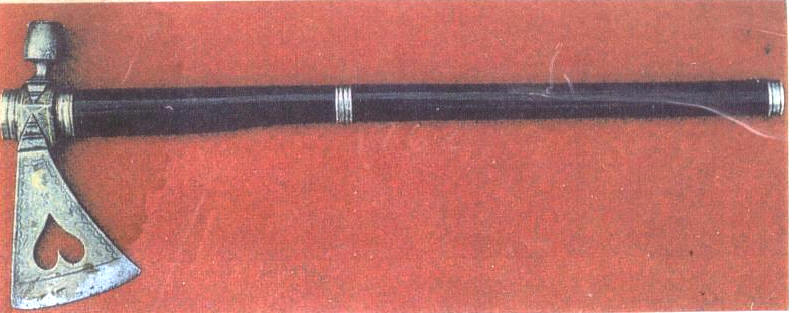 |
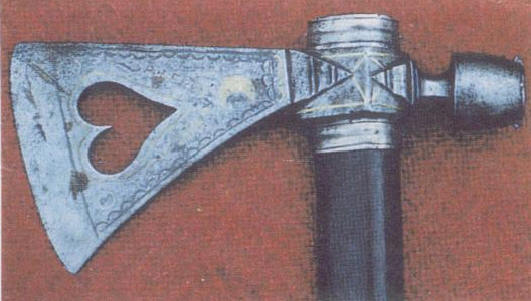 |
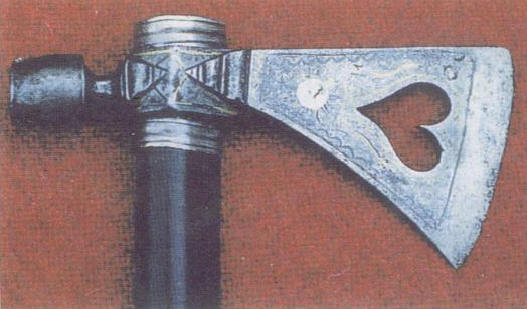 Below ("F.P. lecompte" engraved French Presentation Tomahawk: Courtesy of Alan Gutchess)
|
| French Presentation Tomahawk : French dated head with brass overlay on the straight bowl. On the high shoulder of the upper eye section is engraved "A.R." and on the opposite side dated "1760". The edges of the blade are in a cut out design with a silver inlay on each side just below the molding. Notice the sun rays and a fleur-de-lys engraved on the blade.. |
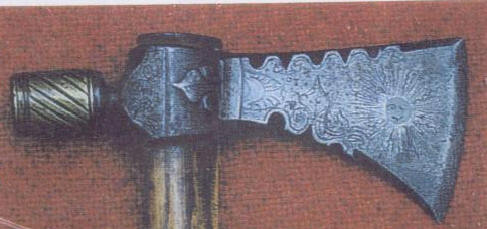 |
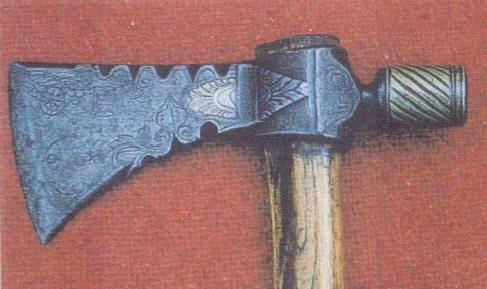 Below (A.R. engraved French Presentation Tomahawk: Courtesy of Alan Gutchess)
|
| French Presentation "casse-tête à calumet" : Finely forged head with straight bowl and molding on the top and bottom. The mid-section is diamond faceted and it has a small neck. The eye section is wide with chevons coming up from the blade. The edge of the blade has cut out designs with a brass inlay on the obverse of a fleur-de-lys, and on the reverse sun rays with the center circle missing. 6 1/4" X 2 3/8" |
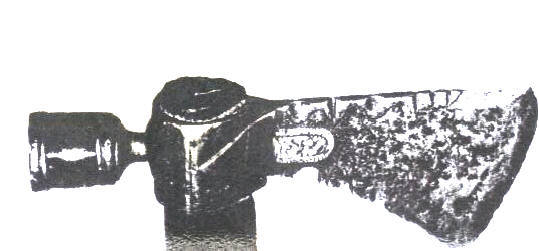 |
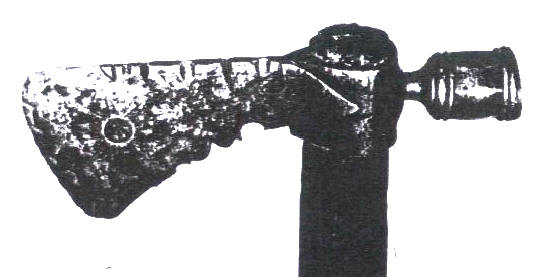 |
| French Presentation "casse-tête à calumet". Multi-faceted, tall bowl with a thin neck and squarish shoulders. The chevron is in relief coming up from the blade around the oval eye. The obverse of the face is engraved with a sun king and on the reverse a pair of scales. There are silver inlays just below the blade molding which are engraved with the letter "R" on one side and "1760" on the other. |
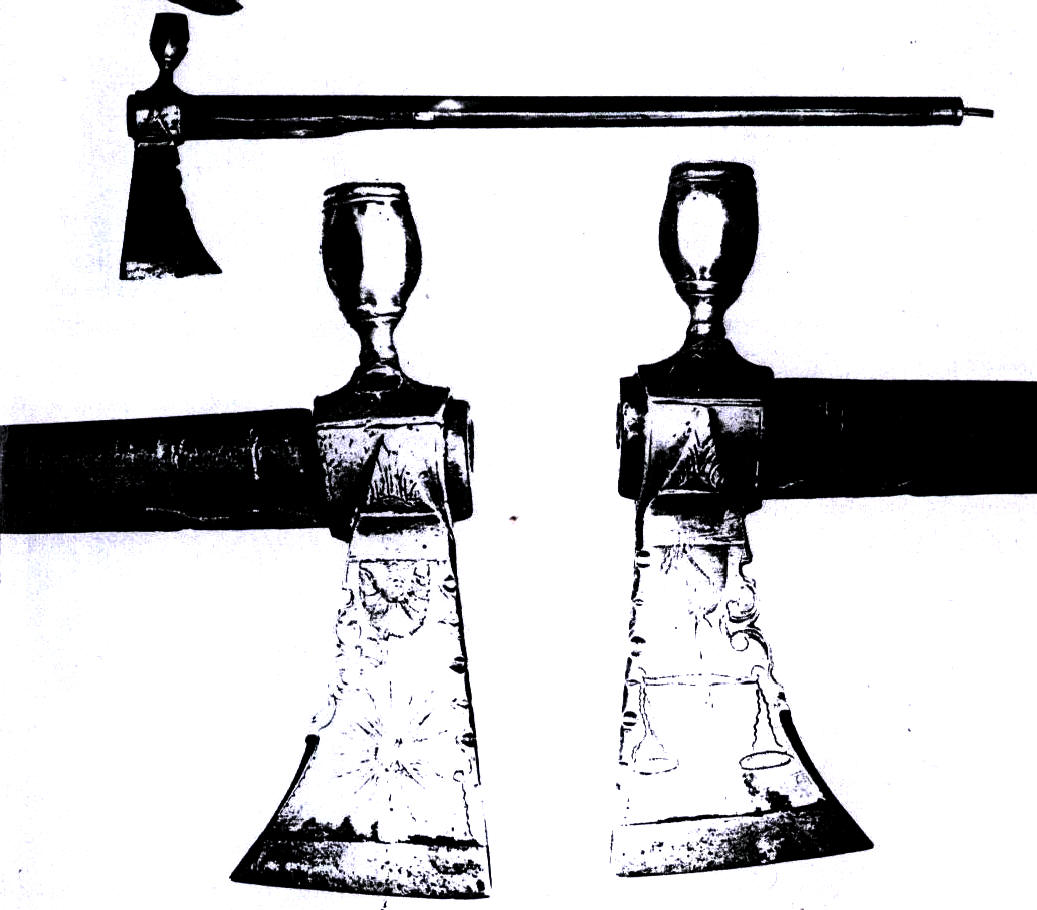 |
| French Presentation
"casse-tête à calumet",
with cylindrical handle of polished hard wood, and combination axe-blade and
pipe bowl of iron ornately engraved, with silver inlays. The date
"1762" (the 2 is reversed) is engraved around the pipe bowl.
Middle and ends of handle are banded with silver. L. 47 cm; Blade and bowl 16 cm X 6.5 cm Tribe unknown |
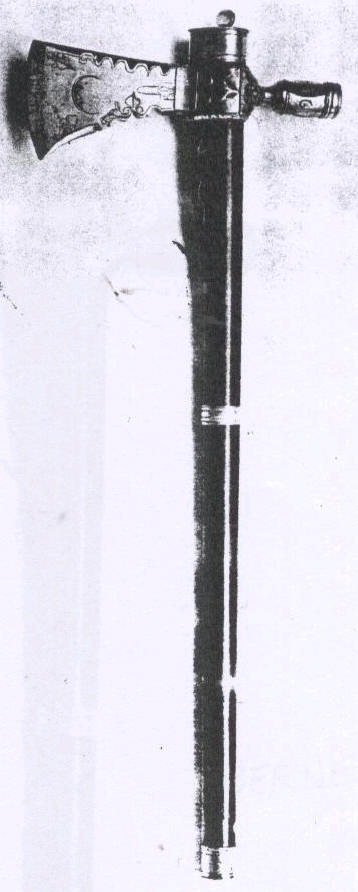 |
 Pipes tomawk (axe and pipe). Gifts made by the europeens to the native chiefs during the 18th century after the conquest of 1763. Lenght : 47 cm. In the permanent collection of the "Musée de l'homme", Paris, France. |
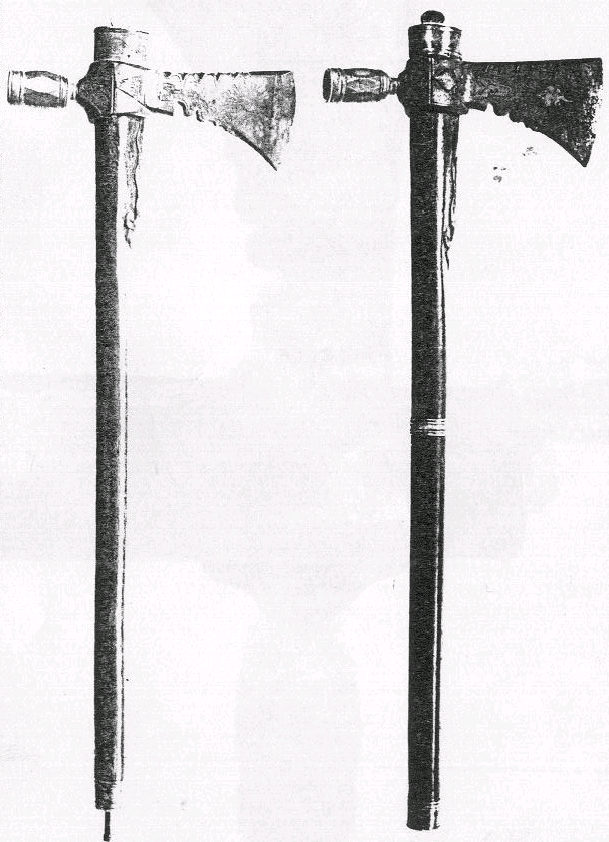 |
 Pipes tomawk (axe and pipe). Gifts made by the europeens to the native chiefs during the 18th century after the conquest of 1763. Lenght : 47,5 cm. In the permanent collection of the "Musée de l'homme", Paris, France.
|
| Pipes
tomawk (axe and pipe). Gifts made by the europeens to the native
chiefs during the 18th century after the conquest of 1763. Lenght :
47,5 cm. In the permanent collection of the "Musée de l'homme", Paris,
France.
|
| Close-up view and full view of the 'Sun' with missing fleur-de-lis and cut designs on a 1760 French tomahawk pipe axe. Excavated in Madison, Wisconsin, in 1911. John Baldwin collection.2 |
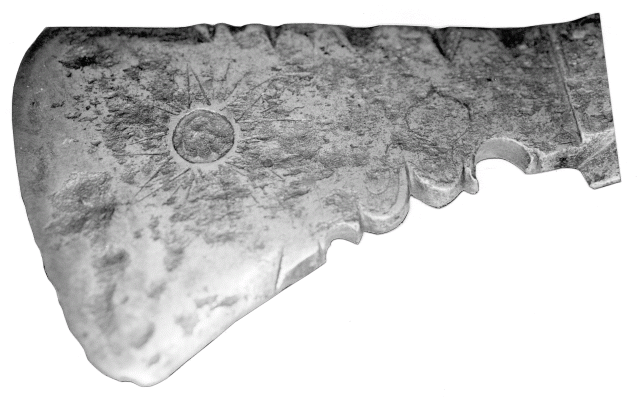
|
| Bellow top: forged brass, inlayed and engraved Louis the 14th tomahawk pipe axe. It is 6 1/8 inches long, 2 3/8 inches wide. Bellow bottom: a cast-brass Louis the 14th presentation pipe axe. It is 5 1/4 inches long, 1 9/16 inches wide.2 |
1.Timothy J. Kent, "Ft Pontchartrain at Detroit, Volumes I & II", Silver Fox Enterprises, 2001.
2.John Baldwin, French Tomahawk Heads, West Olive, Central States Archaeological Societies, October, 2004.